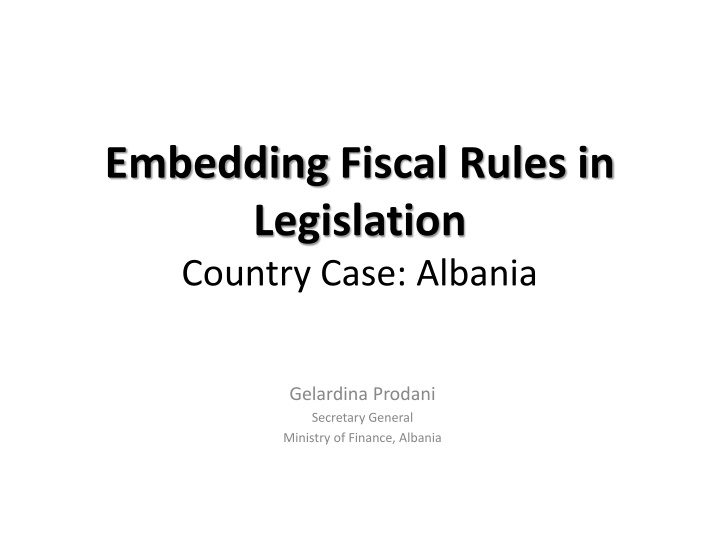
Embedding Fiscal Rules in Legislation: Albania Case Study
Explore how fiscal rules act as commitment devices and signaling tools in the context of Albania's fiscal policy framework. Delve into the principles of designing effective fiscal rules, the trade-offs involved, and the specific case of Albania's fiscal rules since 2008, highlighting the challenges faced and the impacts on public debt levels.
Download Presentation

Please find below an Image/Link to download the presentation.
The content on the website is provided AS IS for your information and personal use only. It may not be sold, licensed, or shared on other websites without obtaining consent from the author. If you encounter any issues during the download, it is possible that the publisher has removed the file from their server.
You are allowed to download the files provided on this website for personal or commercial use, subject to the condition that they are used lawfully. All files are the property of their respective owners.
The content on the website is provided AS IS for your information and personal use only. It may not be sold, licensed, or shared on other websites without obtaining consent from the author.
E N D
Presentation Transcript
Embedding Fiscal Rules in Legislation Country Case: Albania Gelardina Prodani Secretary General Ministry of Finance, Albania
Few words on general functions of fiscal rules Rules are commitment devices: they make deviations from socially desirable targets too costly for policymakers. Rules are signaling tools: they can help policymakers signal their genuine commitment to sustainable and stabilizing policies. Rules can also serve to anchor expectations, thus reducing uncertainties and risk premia.
Principles of a taxonomy Many parameters enter the design of an actual fiscal policy rule: fiscal target(s) nature of costs in case of deviation monitoring/enforcement escape clauses, etc. A good rule must imply good policies in most (if not all) circumstances the policy response induced by the rule to a variety of shocks is therefore key.
The design of fiscal rules There is no one-size-fits-all fiscal policy rule. Much depends on: Constellation of shocks prevalent in the economy Nature and magnitude of policy bias under discretion. A good rule is (Kopits and Symansky, 1998): simple transparent coherent with the final goal but mindful of other goals of public policy: Not discouraging structural reforms Allowing for fiscal stabilization (time-frame, cyclical adjustment) Avoiding low-quality adjustments (undue tax hikes, cuts in quality/priority spending).
Two key trade-offs Credibility-flexibility: allowing for greater responsiveness to shocks could undermine credibility of attaining the final goal. Flexibility-simplicity: combinations of rules can relax somewhat the credibility-flexibility trade-off, at the cost of simplicity and transparency. The devil is in the details
Fiscal rules in Albania Since 2008 Albania introduced in LOB a simple debt-fiscal rule: Public debt must not exceed 60% of GDP However, it was abrogated in the end of 2012.Why? First, the rule was very simple and became binding only in bad economic times, when typically more fiscal space is needed. Second, because it was possible for the government to change the law as it was a simple majority law. After a taught discussion with arguments mostly from MoF to abide by the rule and other pseudo-Keynesian arguments mostly from other parts of the incumbent to pursue an expansionary fiscal policy, the latter won and the Parliament removed the rule from LOB... Once the fiscal rule abrogated the debt quickly climbed to above 60% and now is roughly 72%.
Fiscal rules in Albania Now the discussion on introducing by law a fiscal rule has emerged again, however the positioning of stakeholders seems the same as in the time when the previous fiscal rule was abrogated. MoF and other institutions (particularly EC) which appeal to enforce by law an appropriate fiscal rule and other parts of the government which think we don t need one. Nevertheless, we have prepared a draft-law which is being discussed among different institutions/organisations.
Main features of the proposed Fiscal Rule in Albania We propose that the rule will be a stand-alone law approved and therefore could only be changed with a qualified majority (i.e. 3/5 of the Parliament members in order to be long-lasting). Thus, is has been called The Code of Fiscal Responsibility in Albania The main aim is to reduce the public debt to GDP ratio to about 45% of GDP by 2030 The main mechanism to achieve this long-term aim is that each new government must approve in the Parliament a Fiscal Strategy to reduce the debt by a pro-rata of at least 7% of GDP during its four year mandate. The Fiscal Strategy must be approved before the new government approves its first annual budget law.
Main features of the proposed Fiscal Rule in Albania The main annual operational target which will be determined in the Strategy will be the nominal overall fiscal balance flour (deficit or surplus) in Lek. This annual targets will become legally obligatory to be respected in each annual budget law during the government mandate. The deviation from these annual targets once set in the Strategy could only take place in extraordinary circumstances clearly specified in the law or only by an ad-hoc approval of the Parliament by at least 3/5 of its members.
Main features of the proposed Fiscal Rule in Albania Given the historic bias in governments macro projections, we have provisioned in this Code that the nominal GDP projections used for the debt to GDP ratio in the Strategy and thus for the determination of annual nominal targets of overall fiscal balance will those published in the latest WEO report of the IMF. That means that should the actual economic performance (actual nominal GDP) would come out to be lower or higher than the IMF projections used initially in the Strategy, the debt reduction during the full government mandate will be respectively less or more than the pro-rata of 7% of GDP. Inherently, this acts as the counter-cyclical component of the fiscal rule.
An hypothetic illustration of the rule Growth assumptions for each year 2016-2030 : Real growth 4.0 Deflator 2.0 Nominal growth 6.1 DEBT OBJECTIVE and annual deficit levels to reach debt objective 80 05 71.3 69.6 67.8 04 66.1 70 64.3 62.5 4.0 60.8 DEBT in % of GDP 59.0 04 57.3 60 55.5 53.8 52.0 Deficit % of 50.3 03 48.5 46.8 50 45.0 GDP 03 40 2.3 02 2.2 2.1 2.0 30 1.9 1.8 02 1.7 1.6 1.5 1.4 20 1.3 01 1.2 1.1 1.0 0.9 10 01 0 00 2015 2016 2017 2018 2019 2020 2021 2022 2023 2024 2025 2026 2027 2028 2029 2030 Annual Debt trajectory/targest toward the final objective avarage annual deficits to reach the finale debt objective of 45% in 2030
Main features of the proposed Fiscal Rule in Albania We believe that the designed fiscal rule embodies some very important desirable features a fiscal rule should have, especially in the context of Albania, and these features are harmonized in an optimal trade-off between each other: It is effective to ensure the long term reduction of public debt and strengthening the long term sustainability of public finance It is simple enough to be understood and interpreted without ambiguity not only be experts, but most importantly by politics, public opinion and relevant institutions in charge of assessing the law compliance (courts, prosecutor, supreme state audit, etc.). It leaves some reasonable room for counter-cyclical stabilizing fiscal policy.






















